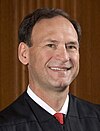User:Superb Owl/sandbox/US Supreme Court
US Supreme Court
[edit]Criticism
[edit]Outdated and an outlier
[edit]The rules governing the institution were last updated in 1795 with the Eleventh Amendment to the U.S. Constitution, leading ___ to argue that many of the critiques can only be addressed through a constitutional update that ensures a less partisan court through rules instead of norms.[citation needed]
Can be captured indefinitely
[edit]See also: One-party state, Democratic backsliding in the United States
Summarize the democratic backsliding section more generally than listing the takes of individual academics.
The conservative majority, in place since 1969, could go on indefinitely without allowing a liberal majority to form. Single-party often leads to the party in power using that power to further entrench their advantage.[citation needed]
Some predictions as to when the earliest the US would likely see a liberal majority again range from 2040 to ___.[citation needed]
Proposed fixes for this include regularly spaced term limits to increase the likelihood of a transfer of power in the court that aligns with election cycles instead of the random chance of when a justice retires or passes away.[1] As-is, justices could simply wait until their party controls both the presidency and the senate and retire all at once and nominate some young replacements, giving a decades-long advantage or more depending on life-extending medical advances).[citation needed]
(Way to have a version of this chart that shows more detail (5-4 vs. 6-3, etc.))

| Party* | Most Recent Majorities | Latest Majority |
| Republican | 2020-present | 6-3 |
| Republican | 1969-2020 | 5-4 |
| Democrat | 1962-1969 | 5-4 |
*WCAG 2.1 Issues...find consensus on content and another way to display
Last updated:
Majority party: Republican (6-3)
Majority since: 1969
Previous majority: Democrat (1962-1969)
Update Template:Infobox court
| Appointed by: |
| Republican |
| Democrat |
| Circuit* | Justice | Appt. by |
|---|---|---|
| District of Columbia Circuit | Roberts | R |
| First Circuit | Jackson | D |
| Second Circuit | Sotomayor | D |
| Third Circuit | Alito | R |
| Fourth Circuit | Roberts | R |
| Fifth Circuit | Alito | R |
| Sixth Circuit | Kavanaugh | R |
| Seventh Circuit | Barrett | R |
| Eighth Circuit | Kavanaugh | R |
| Ninth Circuit | Kagan | D |
| Tenth Circuit | Gorsuch | R |
| Eleventh Circuit | Thomas | R |
| Federal Circuit | Roberts | R |
*WCAG 2.1 Issues...find consensus on content (importance of the circuit role) and another way to display
This 10-3 imbalance gives the appearance of partisanship.[citation needed]
Democratic backsliding
[edit]...Huq? cites Collins v. Yellin (2021) that removed the possibility of congress creating non-partisan prosecutorial office to investigate presidential abuses or high-level malfeasance.[citation needed]
___ credits the Supreme Court with swinging 5 house races in 2022 for the republican party, giving them enough for a majority.[citation needed]
Membership
[edit]| Supreme Court of the United States | |
|---|---|
 | |
| Established | March 4, 1789[2] (Last update: 1795) |
| Location | Washington, D.C. |
| Composition method | Presidential nomination with Senate confirmation |
| Authorised by | U.S. Constitution |
| Judge term length | Life tenure |
| Number of positions | 9 |
| Website | supremecourt |
| Justice | Appointed by (Political party) | SCV | Birthdate (age) and place | Start date (age)
Length of service | |
|---|---|---|---|---|---|

|
(Chief) | G. W. Bush (R) | 78–22 | Jan 27, 1955(69) | Sep 29, 2005(50)
19 years, 50 days |

|
Clarence Thomas | G. H. W. Bush (R) | 52–48 | Jun 23, 1948(76) | Oct 23, 1991(43)
33 years, 26 days |

|
Samuel Alito | G. W. Bush (R) | 58–42 | Apr 1, 1950(74) | Jan 31, 2006(55)
18 years, 292 days |

|
Sonia Sotomayor | Obama (D) | 68–31 | Jun 25, 1954(70) | Aug 8, 2009(55)
15 years, 102 days |

|
Elena Kagan | Obama (D) | 63–37 | Apr 28, 1960(64) | Aug 7, 2010(50)
14 years, 103 days |

|
Neil Gorsuch | Trump (R) | 54–45 | Aug 29, 1967(57) | Apr 10, 2017(49)
7 years, 222 days |

|
Brett Kavanaugh | Trump (R) | 50–48 | Feb 12, 1965(59) | Oct 6, 2018(53)
6 years, 43 days |

|
Amy Coney Barrett | Trump (R) | 52–48 | Jan 28, 1972(52) | Oct 27, 2020(48)
4 years, 22 days |

|
Ketanji Brown Jackson | Biden (D) | 53–47 | Sep 14, 1970(54) | Jun 30, 2022(51)
2 years, 141 days |
*WCAG 2.1 Issues...find consensus on combining columns and another way to display
| Appointed by: |
| Republican |
| Democrat |
Further reading
[edit]- The Supermajority: How the Supreme Court Divided America[4]
Positions/records
[edit]Presidents of both parties tend to view the idea that they should have more power more positively once in office,[5] with Joe Biden being a notable exception?[citation needed][verification needed]
Adjectives
[edit]executive aggrandizement[6][better source needed]
"so-called" and "expansive interpretation"[7]
"selective" in its reading of the constitution[8][better source needed] or "inconsistent" in application of originalism[9]
"ahistorical" and of a "dubious pedigree"[10]
In use in article
[edit]"a defining characteristic of autocracy."[11]
"laughable"[12]
"quasi legal doctrine"[13]
References
[edit]- ^ Litt, David (2020). Democracy in One Book or Less: How It Works, Why It Doesn't, and Why Fixing It Is Easier Than You Think. Ecco. ISBN 0062879367.
- ^ Lawson, Gary; Seidman, Guy (2001). "When Did the Constitution Become Law?". Notre Dame Law Review. 77: 1–37. Archived from the original on October 26, 2020. Retrieved October 23, 2017.
- ^ "Current Members". www.supremecourt.gov. Washington, D.C.: Supreme Court of the United States. Archived from the original on July 21, 2011. Retrieved October 21, 2018.
- ^ Waldman, Michael (2023). The supermajority: how the Supreme Court divided America (First Simon & Schuster hardcover ed.). New York London ; Toronto ; Sydney ; New Delhi: Simon & Schuster. ISBN 978-1-6680-0606-1.
- ^ Skowronek, Stephen; Dearborn, John A.; King, Desmond S. (2021). Phantoms of a beleaguered republic: the deep state and the unitary executive (New ed.). New York, NY: Oxford University Press. p. 34. ISBN 978-0-19-754308-5. OCLC 1163936736.
- ^ Goldsmith, Jack (January 31, 2010). "The Accountable Presidency". The New Republic. ISSN 0028-6583. Retrieved 2024-07-30.
- ^ "The 2024 Executive Power Survey – Unitary Executive". The New York Times. 2023-09-15. ISSN 0362-4331. Retrieved 2024-07-19.
- ^ Dodds, Graham G.; Kelley, Christopher S. (2024), Akande, Adebowale (ed.), "Presidential Leadership and the Unitary Executive Theory: Temptations and Troubles", Leadership and Politics, Cham: Springer Nature Switzerland, pp. 537–553, doi:10.1007/978-3-031-56415-4_22, ISBN 978-3-031-56414-7, retrieved 2024-07-18 "The second segment details the theory, which emerged during the Reagan Administration, draws on select phrases in the U.S. Constitution, advocating that all executive branch activities should fall exclusively under presidential authority."
- ^ Birk, Daniel D. (January 2021). "Interrogating the Historical Basis for a Unitary Executive". Stanford Law Review. 45 (6): 2177. doi:10.2307/1229142. ISSN 0038-9765.
- ^ Dorf, Michael C. (2023-06-19). "The Misguided Unitary Executive Theory Gains Ground". verdict.justia.com. Retrieved 2024-07-18.
- ^ Driesen, David (2020-11-01). "The Unitary Executive Theory in Comparative Context". UC Law Journal. 72 (1): 1. ISSN 0017-8322.
- ^ Ornstein, Norman (June 26, 2007). "Blog: Cheney's chutzpah". The Economist. ISSN 0013-0613. Retrieved 2024-07-11.
- ^ Pilkington, Ed (2024-06-07). "Trump plots capture of DoJ in renewed assault on US justice system". The Guardian. ISSN 0261-3077. Retrieved 2024-07-11.
- ^ Dodds, Graham G. (2023), Akande, Adebowale (ed.), "Is the President a King? The Unitary Executive Theory and the Presidency of Donald J. Trump", U.S. Democracy in Danger: The American Political System Under Assault, Cham: Springer Nature Switzerland, pp. 487–517, doi:10.1007/978-3-031-36099-2_21, ISBN 978-3-031-36099-2, retrieved 2024-07-12
- ^ Wendling, Mike (July 7, 2024). "Project 2025: A wish list for a Trump presidency, explained". BBC.
...a controversial idea known as 'unitary executive theory'
